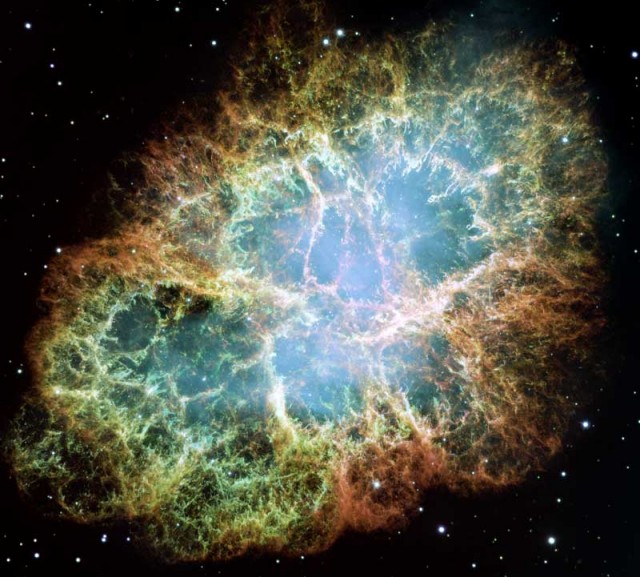
|
Credit & Copyright: NASA,
ESA,
J. Hester, A. Loll (ASU)
Acknowledgement: Davide De Martin (Skyfactory)
Explanation:
The Crab Nebula is cataloged as M1, the first object on
Charles
Messier's famous list of things which are not comets.
In fact, the
cosmic Crab
is now known to be a
supernova remnant,
an expanding cloud of debris from the death explosion of a massive star.
Light from that stellar catastrophe was first
witnessed
by astronomers on planet Earth in the year 1054.
Composed of 24
exposures taken in October 1999, January 2000,
and December 2000, this
Hubble Space Telescope mosaic spans about six light years.
Colors in the intricate filaments trace the light emitted from atoms
of hydrogen, oxygen, and sulfur in the debris cloud.
The erie blue interior glow is emitted by high-energy electrons
accelerated by the
Crab's central pulsar.
One of the most exotic objects known to modern astronomers,
the pulsar is
a neutron star, the spinning remnant of the
collapsed stellar core.
The Crab Nebula lies about 6,500 light-years away in the
constellation
Taurus.
Acknowledgement: Davide De Martin (Skyfactory)
|
January February March April May June July August September October November December |
| ||||||||||||||||||||||||||||||||||||||||||||||||
NASA Web Site Statements, Warnings, and Disclaimers
NASA Official: Jay Norris. Specific rights apply.
A service of: LHEA at NASA / GSFC
& Michigan Tech. U.
Based on Astronomy Picture
Of the Day
Publications with keywords: Crab Nebula - M 1 - supernova remnant - pulsar
Publications with words: Crab Nebula - M 1 - supernova remnant - pulsar
See also:
- APOD: 2025 October 1 Á NGC 6960: The Witchs Broom Nebula
- APOD: 2025 August 24 Á The Spinning Pulsar of the Crab Nebula
- APOD: 2025 June 9 Á Between Scylla and Charybdis: A Double Cosmic Discovery
- M1: The Incredible Expanding Crab
- Supernova Remnant Cassiopeia A
- APOD: 2025 January 8 Á Supernova Remnants Big and Small
- APOD: 2024 September 18 Á The Mermaid Nebula Supernova Remnant
